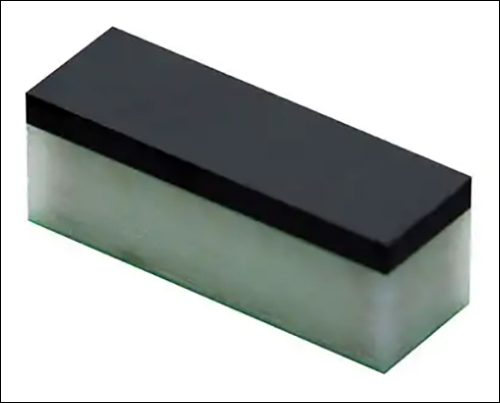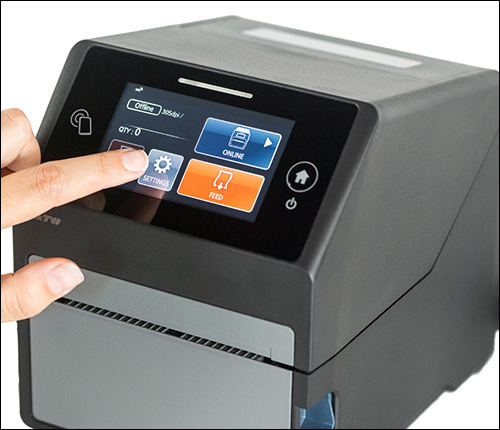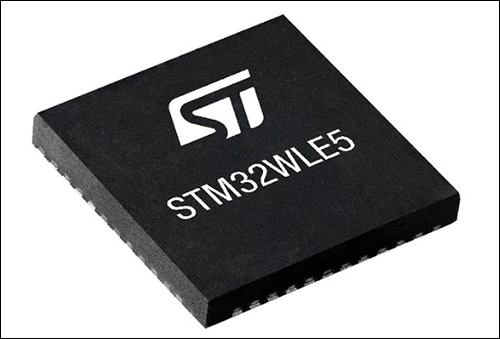Presented here are news announcements made during the past week by the following organizations:
Murata Electronics;
SATO;
Schreiner MediPharm;
STMicroelectronics;
Bluebird; and
the NFC Forum.
Murata Electronics Intros On-Metal Tool-Tracking Tag
Murata Electronics has announced its LXTBKZMCMG-010 RFID tag, designed to be placed directly on metal items, such as surgical tools. The solution can be incorporated into any device’s tool-tracking system, Murata reports, enabling users to determine a specific item’s usage and warranty status, and to assign user accountability. These features are intended to help companies improve loss prevention, reduce the amount of time workers spend searching for tools and provide data analytics.
Measuring 6 millimeters by 2 millimeters by 2.3 millimeters (0.23 inch by 0.08 inch by 0.09 inch), the tag has a read range up to 150 centimeters (59 inches) and covers the UHF frequency band range of 865 to 928 MHz. This allows for multiple items to be read simultaneously, the company explains. The tag meets the EPCglobal Gen 2v2 standard and is 100 percent RoHS-compliant, according to the company.

“Murata’s ability to continually push the technology envelope and develop advanced products that solve some of the most complex design challenges is evident in this latest solution,” said Gerry Hubers, Murata Electronics’ business-development manager, in a prepared statement. “Perhaps the most significant benefit that the LXTBKZMCMG-010 delivers is providing critical real-time data analysis to key stakeholders, such as operations, plant managers or technicians in the field.”
SATO Offers Printer Capable of Encoding RFID Labels
SATO, a provider of automatic-identification and labeling solutions, has announced its CT4-LX smart mini-label printer. Equipped with a color touch-panel LCD, the printer is designed for operators of varying skill levels across multiple sectors and geographic regions, the company reports.
The CT4-LX RFID model can read and encode RFID labels in the UHF and HF frequency bands. In order for users to write labels stably with a printer, individual configuration settings are typically required for each type of RFID label. The CT4-LX RFID, however, can read and encode UHF RFID labels automatically for fast, stable encoding. Some RFID features will be added soon, according to the company.

As economy diversification creates a shortage of skilled labor and a more competitive job market, SATO explains, the retail, warehousing, transportation, logistics, food manufacturing and health-care sectors face the challenge of procuring and retaining human resources at worksites where variable data labels are printed, and there is an increasing need to improve productivity using smaller, more diverse teams. Therefore, SATO designed the CT4-LX to be suitable across many different worksites.
The interactive smart printer can support existing applications and operations, and the device allows users to print labels without a PC by connecting to a number of peripherals. A label waste-prevention feature automatically senses the first label. The CT4-LX is equipped with a 4.3-inch color TFT LCD touch panel. If an error occurs, it can be overcome quickly with the help of simple instructions or a video, the firm indicates.
According to SATO, the printer has a small footprint, is shaped to be suitable for various environments, and supports menu display in 31 languages and printing in 47 languages. It is designed to serve as a common model for customers with workforces deployed worldwide, the company notes, and a Media Profile Function allows the registering and saving of settings for each label.
Schreiner MediPharm Unveils RFID Label, Supply Chain Security Solutions
Schreiner MediPharm, a provider of labels for the pharmaceutical industry, has announced its Robust RFID-Label, designed to offer end-to-end functionality from production to final use. The company has also announced two products intended to offer drug container integrity: Cap-Lock, for sealing prefilled syringes, and Flexi-Cap Prime, which irreversibly indicates any tampering attempts on a vial.
Interaction between users and pharmaceutical manufacturers, as well as communication between products and medical devices, are important connectivity-centric aspects for pharmaceutical applications, Schreiner MediPharm explains. Equipping drug products and medical devices with RFID labels, the company adds, results in smart devices that can help businesses optimize processes and enhance ease and safety of use.

The Robust RFID-Label consists of a label-integrated RFID tag secured via the label’s construction. This avoids potential damage to the RFID chip due, for example, to mechanical impact during the manufacturing and handling processes. The chip’s performance is thus assured from production to final use, the firm reports, particularly on round containers with narrow radii. Schreiner MediPharm customizes the label’s design to suit individual applications and drug manufacturing setups, providing companies with a solution designed to support product and patient safety.
Since the EU Falsified Medicines Directive came into effect, tampering with secondary packaging of prescription medicines has been more difficult, the firm reports, but legislation has not yet resolved the issue of ensuring container integrity. With Cap-Lock and Flexi-Cap Prime, Schreiner MediPharm hopes to help users prevent the undetected opening of a primary container, thereby ensuring its integrity. The Cap-Lock cap adapter seals prefilled luer-lock syringes and indicates if a syringe has been previously opened, while the Flexi-Cap Prime cap label makes any attempt to tamper with a vial irreversibly visible.
STMicroelectronics Rolls Out System-on-Chip for LoRa IoT
STMicroelectronics, a semiconductor company serving customers across multiple electronics applications, has announced a LoRa system-on-chip (SoC) for connecting smart devices to the Internet of Things (IoT) using long-distance wireless connections. The STM32WLE5 SoC allows product developers to create devices such as remote environmental sensors, meters, trackers and process controllers that can help users manage energy and resources. The SoC combines ST’s STM32 microcontroller design with a LoRa-compliant radio in a single-die device. ST’s LoRaWAN software for wireless network communications has passed all regional certifications for use worldwide.
“Our new wireless STM32 SoC extends the existing STM32W Wireless and simplifies new-product development while saving bill-of-materials costs and maximizing system reliability and energy efficiency,” said Ricardo De Sa Earp, the general manager of STMicroelectronics’ Microcontroller Division, in a prepared statement. “In addition, by leveraging the STM32 MCU architecture, we let developers easily introduce wireless connectivity in existing embedded designs by porting to the STM32WLE5.”

The STM32WLE5, available in a 5-millimeter by 5-millimeter (0.2-inch by 0.2-inch) UFBGA73 package, is integrated into the STM32 ecosystem, including STM32Cube software support, as well as a LoRaWAN stack certified for all regions and available in source-code format. Its integrated radio, based on Semtech‘s SX126x IP, comes with dual high- and low-power transmitter modes that cover the global sub-1GHz unlicensed frequency range from 150 MHz to 960 MHz, ensuring compatibility with LoRa networks in all territories. Sensitivity is down to -148 dBm, the company reports, and the device features two embedded power amplifiers.
In addition to the embedded LoRa modulation, the STM32WLE5 is capable of (G)FSK, (G)MSK and BPSK modulation, allowing alternative protocols, including proprietary ones. The microcontroller leverages ST’s STM32L4 architecture, which features Arm‘s Cortex-M4 core with DSP extensions and utilizes ultra-low-power technologies, including dynamic voltage scaling and ST’s adaptive real-time ART Accelerator for zero-wait execution from Flash. 64-, 128- and 256-kilobyte Flash options let developers choose the code and data-storage density for the platform, including application and radio.
In addition, the device utilizes the built-in cyber-security features of the STM32L4 microcontrollers, including hardware public key accelerator (PKA), True Random Number Generator (TRNG) and sector protection against read-write operation (PCROP). It also comes with support for cryptographic algorithms, including RSA.
Bluebird Debuts New IoT RFID Products
Bluebird, an Internet of Things (IoT) solution provider, has announced several new RFID products designed to improve productivity. The systems are designed to be set up and managed within an IoT environment, the company reports. These new products include the RFR900 handheld RFID reader, which has been widely adopted in the European market, according to the company.
Last year, Bluebird joined the RAIN RFID Alliance, a global alliance focused on promoting the adoption of UHF RFID technologies. The company then released its Bluebird Universe platform, which collects and analyzes data from various IoT devices, as well as solutions designed to provide data management, inventory management, RFID solution development support and operation support.
Bluebird has launched a service that supports the establishment of the IoT and its continuous operation and management. The company also provides support services, including RFID consultation design, ranging from workflow for corporate RFID environment establishment to solution design consultation, PoC, introduction, security management, warranty extension and employee training.
“Bluebird has developed its technological capability to actively respond to rapid market flows over the past 20 years,” said Jang Won Lee, Bluebird’s CEO, in a prepared statement. “We have always been going forward with evolving technology. We will take another leap forward global top tier with the new RFID products in the market rapidly reshaping with RFID.”
NFC Forum Releases New Specifications
The NFC Forum, a global standards body and advocacy association for Near Field Communication (NFC) technology, has released four new specifications intended to improve the robustness and communications speed for the more than two billion NFC-enabled devices currently in use, including smartphones. These specs were created to improve the user experience in noisy radio environments, the organization explains, by adding recovery rules and enhanced performance for the development of new use cases, utilizing the Tag NFC Data Exchange Format Exchange Protocol Specification (TNEP).
NFC is now a standard feature on smartphones. Its ability to connect or pair with other technologies, like Bluetooth and Wi-Fi, enables an array of solutions, the NFC Forum explains, while simplifying the user experience. “We are constantly improving on the global specifications to improve the overall user experience for NFC users. NFC Forum members take this responsibility very seriously as their decisions impact the majority of smartphone users and many businesses,” said Mike McCamon, the NFC Forum’s executive director, in a prepared statement. “The specifications we are announcing today enhance the quality of NFC communications and allow users to exchange more data, faster in support of the rapid increase we are seeing in the use of TNEP.”
Digital Protocol Technical Specification Version 2.2: This specification addresses the digital protocol for NFC-enabled device communication, providing an implementation specification on top of the ISO/IEC 18092 and ISO/IEC 14443 standards. The new specification adds error recovery for Type 2 and Type 5 Tag communication. This update improves the user experience by ensuring reliable NFC communication in difficult environments where NFC communications might be disturbed.
Tag to Type 5 Technical Specifications Version 1.1—Type 2 Tag to Type 5 Tag Specification Version 1.1: This specification defines NFC-enabled devices in reader-writer mode and detects, reads and writes an NFC Data Exchange Format message on NFC Forum tags. The spec was updated to support time-optimized implementations in order to improve performance for reading NFC Forum tags in support of the new TNEP protocol.
Activity Technical Specification Version 2.1 and Profiles Technical Specification Version 1.0: These specifications were created from Activity 2.0 by splitting it into two specs to ease in the future maintenance of these specifications. The Profiles section of Activity 2.0 is now described in the Profiles 1.0 Technical Specification. It adds a new Profile to discover all services eventually offered with different technologies. The specification explains how the NFC Digital Protocol Specification can be used to set up the communication protocol with another NFC device or NFC Forum tag.

